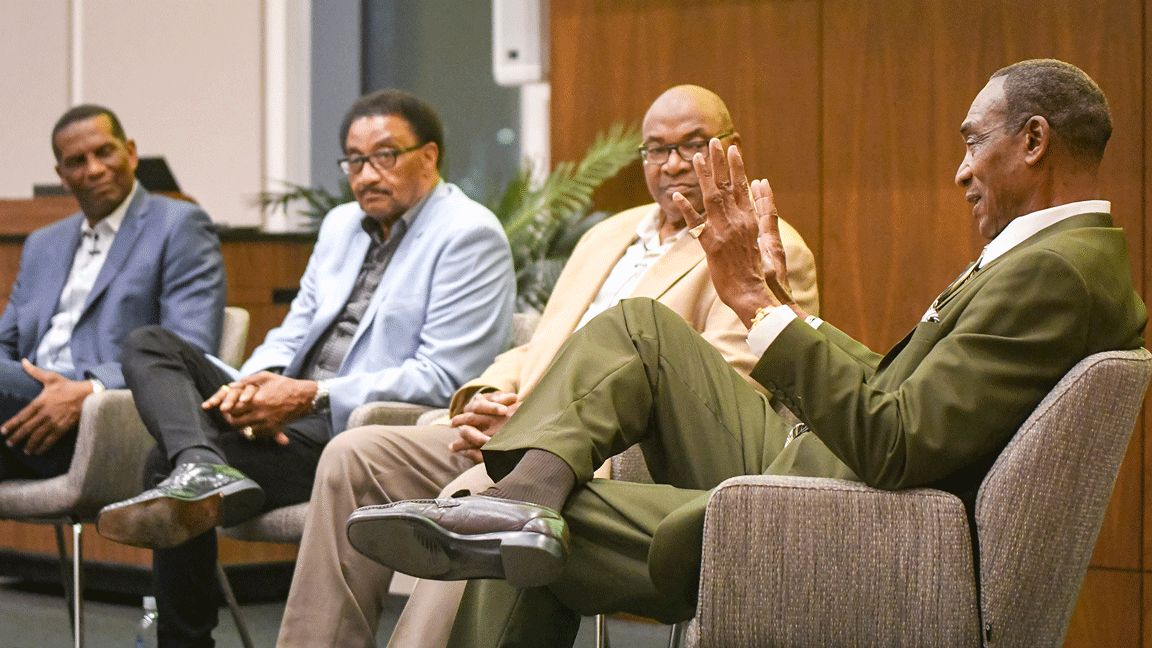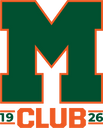
Canes Football Pioneers Return to Campus
By Christy Cabrera Chirinos
HurricaneSports.com
CORAL GABLES, Fla. – For more than an hour, they sat and reminisced.
They recalled how their opponents treated them on the field. How some were the first in their families to go to college. How they were willing to play any positions their coaches asked. And they shared how, in a time of transition and fierce racial tensions, they found an “oasis” at the University of Miami.
Former Hurricanes football legends Burgess Owens, Chuck Foreman, Rubin Carter and Ray Bellamy were among the first four black athletes to wear Miami’s orange and green. And earlier this week, they returned to that oasis to share some of their experiences as part of the Stanford Stories’ Black History Month event.
The Stanford Stories programming series, which began earlier this academic year, is designed to celebrate the Stanford Residential College’s impact on the University of Miami community before the iconic housing tower is decommissioned and construction begins on the new Centennial Village.
Owens, Foreman, Carter and Bellamy – the first African-American to earn an athletic scholarship at Miami – were all Stanford residents. And all of them expressed hope this week that the current group of Stanford residents and Miami students would have experiences as enriching as theirs were.
“Understand where you are and what you’re doing,” said Bellamy, who served as the first black student body president at Miami. “What you’re doing right here, right now, will determine what kind of car you drive, what kind of food you eat, what kind of house you live in, what kind of clothes you wear. … what kind of toys your children will get for Christmas. This is serious. Understand where you’re at and please don’t squander your opportunity. Take advantage of where you are. Look at what you have in here. … You’ve got support. Take advantage of it and realize where you are because we had friends who came to school with us and never got the degrees. Oh, they went to the beach. They were at the pool. … but they didn’t get their degrees. Don’t worry about anything but what you’re doing.”
Added Owens, “I had a chance to come down to the University and it was almost like an oasis in terms of the South. We had people from different parts of the country, around the world and as long as we were on campus, it was an amazing place to be. We learned to look at each other inside out versus outside in. I met some of my first white friends here and we’re still friends today. … We developed bonds, friendships and we saw past that. Isn’t that kind of what the world should be about? I look at this as one of the greatest experiences I had, to see people as who they really are and that has led me throughout my entire life.”
Though each recalled positive experiences during their time at Miami, they also acknowledged that as young black men attending a school in the Southeastern United States, they faced a number of challenges, including racism and discrimination.
Some heard opponents hurl racial epithets at them during games. Foreman, who hails from Maryland, shared how he and his father were stopped by police in South Carolina as they were driving south to Coral Gables. And Bellamy arrived at Miami having heard horror stories about how some of his contemporaries – the first black student-athletes at other schools – had been treated by their own teammates and friends.
“The University of Miami said no, you’re not going to do that here,” Bellamy said. “[Former University President] Henry King Stanford said not here. That wasn’t happening.”
But Owens, Foreman, Carter and Bellamy weren’t just pioneers on campus.
They helped write a significant part of Miami’s history on the football field.
Owens, a safety, earned first-team All-American honors and had a team-high five interceptions in 1971. Foreman’s 3,355 career all-purpose yards still rank ninth in program history. Bellamy saw his playing career end after a serious car accident, but at the time, he ranked among the top eight players in program history in career catches, yards per reception and most yards and catches in a single season. And Carter, who grew up in Fort Lauderdale, would go on to coach at both the college and professional level.
“We were football players. You see these guys with the records here at the University of Miami, but I can tell you one thing: We could’ve played with any of them. They may have the stats, but we’ve got all the other stuff,” said Foreman, a former first-round draft pick of the Minnesota Vikings and five-time Pro Bowl selection. “We came in, we opened the doors, we made the commitments to be the best we could be, in the classroom and on the football field.”






